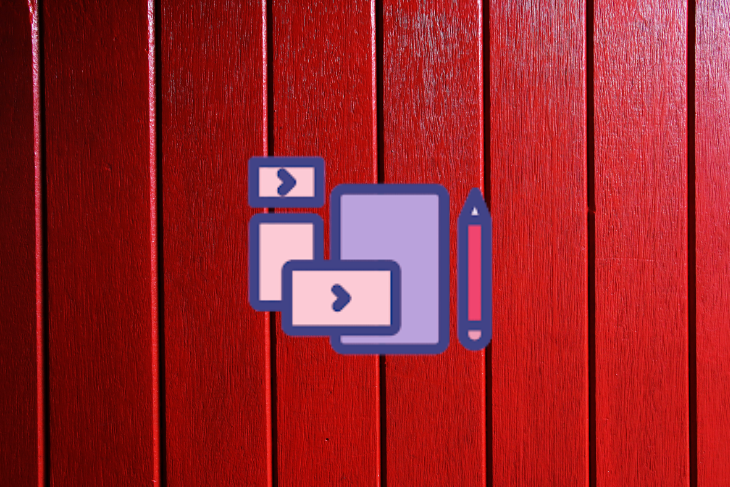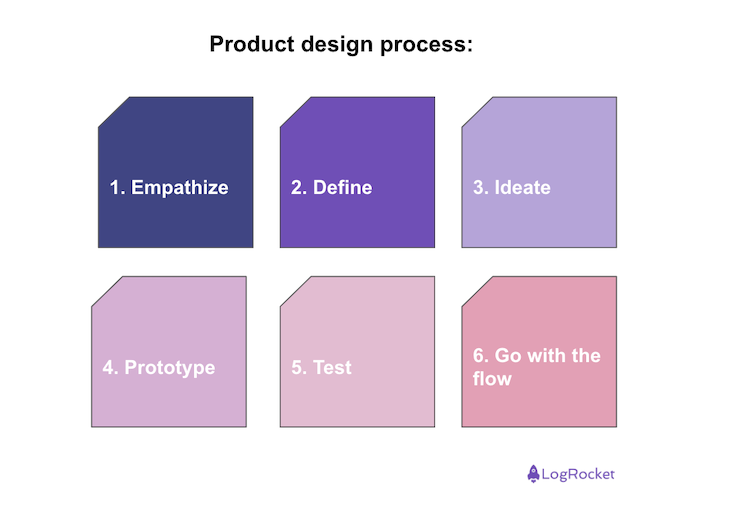Businesses want to make money, but customers only want to pay for good products with quality user experiences. In order to achieve this, you need to have effective UX designers. By putting together a product team that utilizes product design processes, you can bring business and UX together, creating a product that’s better for you and your customers.

In this article, you will learn what product design is, its key stages, and how it will impact your user experience.
Product design is the process of creating, improving, and maintaining products that solve customer and/or user needs. This process is different to that of traditional businesses because traditional businesses seek ways to increase revenue, but lack the direct insight needed to understand what people want and who those people are. The product design process is also different to that of UX designers because UX designers seek ways to improve the user experience of products but aren’t involved in defining what problem the product solves or how it generates revenue.
However, traditional business and UX design roles are still super important. In fact, product teams are where business minds and UX designers come together to focus on revenue and customer/user needs in equal measures (alongside other key roles such as developers and marketers too). For those that are interested in business and UX, well…that’s sort of what a product designer is.
Product design exists at the center of the overall product process. Market research, UX research, developer expertise, and other types of research and expertise feed data and insight into the product design process. It might be unfair to say that product design is the most important part of the overall product process, but it’s certainly the central figure and it’s common to feel like product management is just about managing product designers and design processes.
However, to really maximize value, you’ll need to look at product building from a variety of perspectives, which means leveraging marketers, UX designers, developers, and any other relevant experts too.
There are many product design frameworks designed to help product teams get the most value out of the time and money they invest into building successful (i.e., useful and profitable) products. Each of these frameworks have pros and cons; however, they all pretty much adhere to the following steps:

Stage one is usually to research customer and/or user problems. Some people and frameworks refer to this step as the empathize step, meaning to put oneself in the position of the audience to better understand their wants and needs.
As mentioned earlier, businesses have traditionally taken a revenue-first approach, which is often short-sighted and winds up having an adverse effect, whereas focusing on wants and needs often satisfies target audiences and business objectives. This isn’t always the case, but we’ll get into those scenarios later.
During this stage, the objective is to listen and observe. Popular methods include surveys, focus groups, interviews, and keyword research. It also helps to be present in the communities built around the niche that you’re exploring.
Sometimes you’ll be discovering new problems and other times you’ll be investigating known ones. The design sprint framework only focuses on known problems.
Stage two, sometimes referred to as the define stage, is about summarizing problems. These summarizations are sometimes called problem statements and can be used to screen and prioritize problems.
Screening means to deprioritize problems based on resources available (e.g., time and budgets), or filter out problems that aren’t profitable or don’t align with the mission (i.e., they’re somebody else’s problem to solve). It can be difficult to screen problems based on resources available without knowing how complex the final solution will be; however, product design is just a series of small bets — you win some, you lose some — but you’ll lose much more being indecisive.
Deciding on a problem usually involves a voting process fueled by quantified data from the empathize stage such as how severe or commonplace the problem is, and perhaps market research.
If your product team has a list of known problems that have already been investigated, then you’d probably start with this step.
This stage involves coming up with ways to solve a problem that you’ve decided to solve. Product teams can be subdivided to solve more than one problem at once, but from here on out they’ll be running separate processes (or sprints) to tackle each one independently. However, tackling one problem at a time is usually a better approach.
The first thing that you need to know about this stage is that it’s not necessarily for designers. It embraces raw, imperfect ideas that can be jotted down with nothing more than pen and paper; it democratizes design where the end result is more ideas and perspectives to consider.
For those unsure, there are ideation techniques popularized by some product design frameworks that product teams can adopt regardless of the specific methodology chosen. For example, product teams can totally opt for the design thinking framework while utilizing the four-step sketch method that’s a part of the design sprint framework.
This stage usually wraps up with a vote on which solution appears to be the best, although if you have extra designers and people willing to facilitate user tests, you’re safe to split off at this point and explore multiple solutions.
The stage involves prototyping the chosen solution. Naturally, this stage is for UX designers, although in reality anybody with a reasonable amount of skill with a UI design tool will do as they shouldn’t really be spending too much time on this anyway.
In the meantime, those that aren’t prototyping can plan the user testing sessions as well as gather and screen participants, who could be the same people that you spoke to during the define stage.
In this stage, product teams will conduct user tests to determine to what degree the solution solves their problem and what can be done moving forward.
This is the final stage! Maybe. Probably not. Unless your solution completely knocks it out of the park, you’ll have at least a few suggestions taking you back to the prototyping stage at least once, assuming that users conditionally validated the solution.
If the solution wasn’t validated by any measure then you’ll probably need to take a step back to the ideation stage (unless you have another prototyped solution to test), or several steps back to ensure that you’ve properly uncovered and defined the problem.
As you might’ve guessed already, these stages aren’t always sequential. Product teams sometimes run them in parallel for more efficiency, out of order depending on what knowledge they have already, or repeat stages if the outcomes are underwhelming.
Now that you know more about the different stages of product design, you should be able to adapt as needed. Being able to assess which way the wind is blowing and sail in that direction is probably the greatest strength that product teams can strive for.
As mentioned already, being user-first instead of business-first tends to yield the best outcome for both users and businesses. What’s even better is that this doesn’t mean business-adverse, because estimating the profitability of problems is still something that you can do pretty early on.
However, building a sustainable product still requires you to make business-first decisions sometimes, although they don’t have to be customer-adverse decisions. In scenarios like this, you can apply the product design process to your own business, which could result in optimizing internal processes such as DesignOps and DevOps for example, leading to fewer overheads. This makes it seem as if you’re the customer, although I like to think of it as self-care for businesses.
Other times, the process might start off about you but require user testing later; for example, if it’s decided that you can’t reduce overheads and that raising prices might be the better thing to test. Customer-adverse initiatives are never fun, but at least the product design process enables us to handle them with more care.
UX designers play a critical role in product design teams since they know how to conduct research (useful in the empathizing and testing stages) and use UI design tools (useful during the prototyping stage). They can even play the role of product designer if needed and if they have the bandwidth to do so.
For these reasons and the fact that product design is almost always user-first, product design impacts user experience significantly and usually in a very positive way, assuming that you’re solving big frustrations rather than chasing big profits.
The two biggest trends in product design right now are AI and doing more by doing less.
AI can be used to jump to the halfway point of many tasks such as writing copy, writing survey questions for research, writing in general, generating hypothetical analytics based on limited real data, designing UIs, and more.
Doing more by doing less means having fewer tools for tracking work in order to actually do more work — do we really need Figma comments, Jira, Slack, and G-Suite? Probably not. This applies to communication more than anything — cutting out meetings/standups and communicating via collaboration instead (i.e., doing work instead of talking about it).
The great news is that the same old (not) played out product design frameworks facilitate this and are still very useful today. This includes design thinking, design sprints, lean startup, and more. Even the flawed waterfall framework has its benefits.
There was a time when product design was considered a modern way of working, but today it’s normal to have diverse teams made up of designers, developers, marketers, and so on with the ability to influence business decisions. This is in contrast to the outdated way of working where UX designers would receive a spec from someone and jump straight into the UX design process without ever being involved in the discovery phase or the solution phase.
This resulted in so many UX designers getting half-way through their UX research only to discover that nobody actually wants a product. Today, product design, despite being user-first for the most part, is the safest and most profitable approach to business that companies can take.
Featured image source: IconScout

LogRocket identifies friction points in the user experience so you can make informed decisions about product and design changes that must happen to hit your goals.
With LogRocket, you can understand the scope of the issues affecting your product and prioritize the changes that need to be made. LogRocket simplifies workflows by allowing Engineering, Product, UX, and Design teams to work from the same data as you, eliminating any confusion about what needs to be done.
Get your teams on the same page — try LogRocket today.

Most teams fail at autonomy. Learn how clear rules help product teams move faster without micromanagement.

A practical framework for PMs to use AI in ideation without sacrificing judgment, strategy, or decision quality.

A practical five minute revenue estimation method to help product managers compare ideas, drop low impact features, and prioritize smarter.

A practical guide for PMs who want to stop being bottlenecks, delegate smarter, and lead teams effectively with a clear ownership framework.